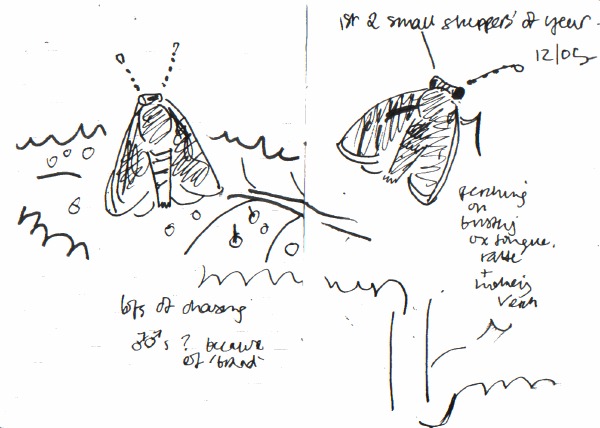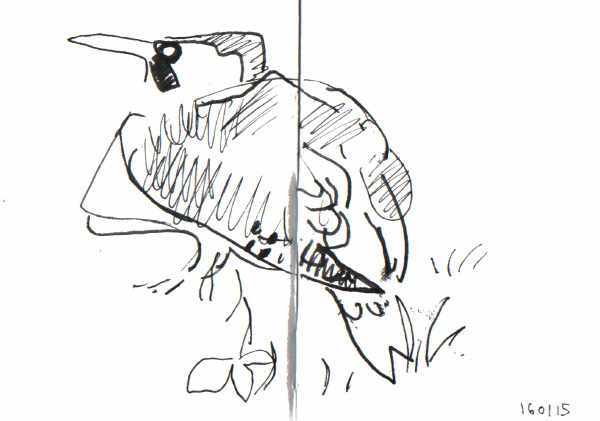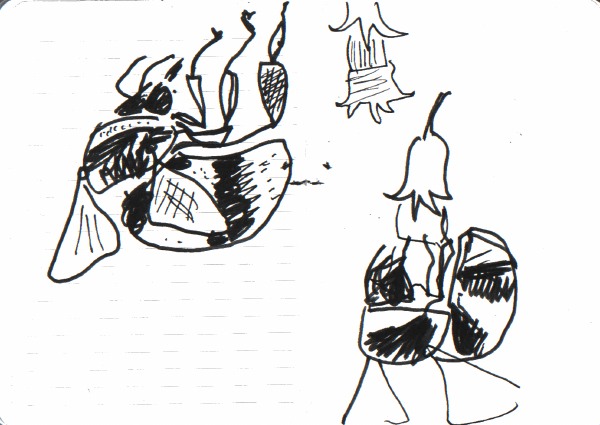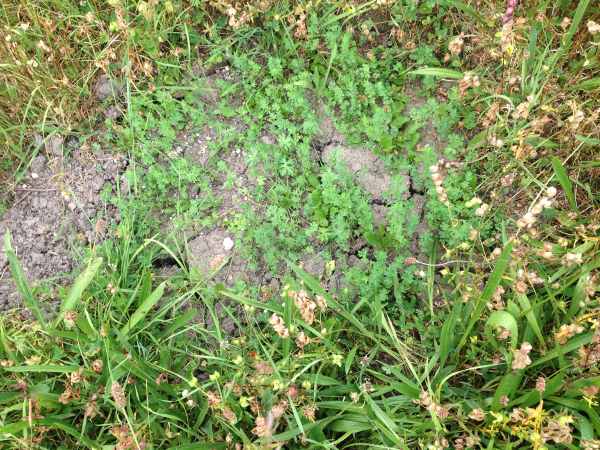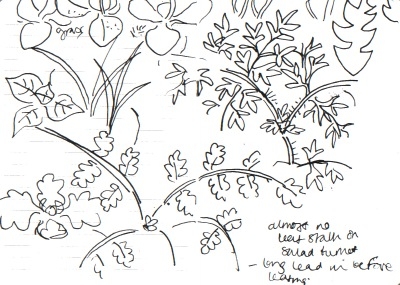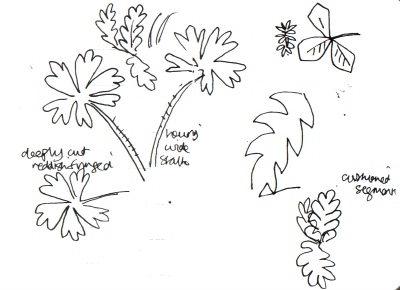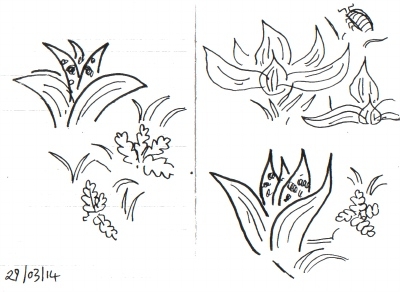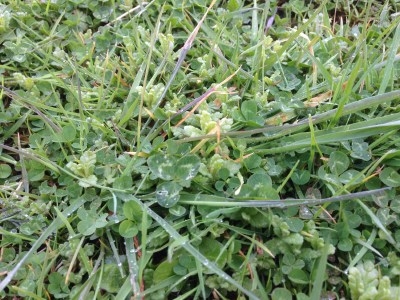This is some text that will display at the top of the Category page.
This is some generic text to describe all other category pages, I could be left blank
Archive For The “meadow-2014” Category
I’ve already covered the bumblebees in separate post
Butterflies
common blue butterfly – first seen on 27th may feeding on the cut-leaved cranesbill. (see the yellow rattle post for more about common blues)

meadow brown on rattle pods – ink pen – A6 sketchbook
Meadow brown & Ringlet – didn’t keep much record of numbers but I think there were a lot more around than the previous year. First meadow brown on 12th june. first ringlet on 16th june
Gatekeeper – plenty around, I think of them as mainly on brambles and marjoram June/July but no good records of numbers or dates.
Peacock
Small tortoiseshell – steadily more of them around it seems, no caterpillars seen despite our neighbouring nettle beds. Maybe I need to do some cutting back of nettles to encourage fresh growth which is what I think they like.
Red Admiral – plenty seen but no particular records kept
Comma – seen regularly but no records, usually basking on bare soil.
Large skipper – on 22/24 june
Small skipper – First seen 12 june. I don’t think there were as many as previous year… I’d guess at maximum count of 10 or so (but this is just on the 4 x 4 metre mini meadow).. often nectaring or sunning (or establishing territory?) on ragwort.
Brimstone – only really noticed in the early days of spring.
Whites – no serious notes made… there is that time in august/september when they seem to floating around like blown paper scraps…
Speckled wood – first of year on 15th april…
Moths –
No moth trapping this year and only really paying any attention to the more showy species.
Seemed like a lot more cinnabar moths including some egg laying on the ragwort. I’ve a note on them for the first time on 14th June… and garden tigers the same day (lots around the 22nd june). We seem to have lots of the tigers … whizzing frenetically around quite high on summer evenings… last year I managed to see one gradually narrow its orbit until it found a female resting on an elder leaf, presumably transmitting pheromones that he was locking on to.
Only one or two burnet moths and no sign of egg laying.
Dragonflies –
2 female broad-bodied chasers on 12 june.
Lots of southern hawkers emerged from the pond along with azure and large red damsels as well as common darters. These don’t really feature on the ‘meadow’. Migrant hawkers are over the allotments from august (?) on.
Highlight of the year birdwise was this cuckoo on 1st may. Seemed extraordinary… in continuous rain I kept thinking I could hear cuckoo from the studio, but couldn’t believe it… thought it might be someone playing around with speakers. Took a very long time to track it down to the top of beech tree, well hidden in the canopy. It was there all day, presumably grounded by the rain. With so much focus on African migrants earlier in the year it seemed all the more amazing that this bird would probably have been in the Congo a few weeks earlier.
swifts arrived over house on 3rd may
I trot out to look each time the herring gulls make a particular alarm call that says there is a raptor overhead. Usually it is a buzzard coasting over… peregrines have usually shot straight through with a flock of pigeons floundering in their wake…but occasionally watched spiralling high. Just once (or twice?) a kite drifting eastwards towards Bath in a purposeful kind of way.
Surprisingly little that I can think of to note down about the smaller birds. Finches have deserted our bird table… I did have one lovely eyeful of greenfinch male feeding on borage… zinging green, yellow & blue but never making it to the paintbrush.
Goldfinches are ever present at least in the ears… often up in the tops of beech, birch or larch… also making use of the great variety of seeding plants up on the allotments.
Willow warblers make their fleeting appearance in early april (6th i noted), coinciding with the air drizzling green.
Chiffchaffs and Blackcaps are around… Blackcaps all year now.
Green woodpecker is often on the allotment and I’m nurturing ant hills for their benefit. Great spots are in the garden.
We still have masses of sparrows, though there is a season (late summer?) where they disappear and I think we may have lost them… but then they come back in mid winter (?).
31 Mar 2014 buying the bee id app. By NatureGuides Ltd.
https://itunes.apple.com/gb/app/bumblebees-britain-ireland/id657077156?mt=8&ign-mpt=uo%3D8
having seen boldly marked bumblebee this morning. Seems like it is Bombus hypnorum the tree bumblebee. One of the 6 commonest spp. Probably a queen… very black abdomen with white tip… ginger thorax the most striking feature.
Following on from this I started to get familiar with our regular bees. The app. is really well designed I think and has helped me to learn the basics very quickly.
Buff-tailed (terrestris)– is probably our commonest bumblebee and it seems like you can see them in any month nowadays…. I watched them on the yellow rattle and where the garden bumblebee (horturum) would whizz from one rattle flower to another (with its tongue lolling) terrestris would be slow moving and I think they had to get to the nectar through the back door… certainly they did with the comfrey flowers (most of which had holes cut in the back to allow access to these bigger shorter tongued bees). A lumbering bear compared to hortorum.
early Bombus pascuorum… mainly remember these on comfrey and on the garden plant Nectaroscordum (a garlic type) . They are really distinctive, small and fast moving, with sulphur yellow bands and the end of the abdomen a hairy egg yolk orange.
I don’t remember seeing many red-tailed (lapidarius)… a big queen throbbing on the outside of the studio…. should have made notes though… can’t be sure there weren’t more.
common carder bumblebee (pascuorum)… probably the second commonest after buff-tailed and they really liked the yellow rattle.
tree bumblebee (hypnorum) was also really common, another one using the back entrance of the comfrey and they were on bramble quite a bit. They also seemed to be round the front of the house a lot (on the street), that is quite a sun trap.
I was never convinced that I’d seen white- tailed (lucorum)… so it seemed like we have 6 species in good numbers. I’ll try and keep better track of when they are active in 2015. Only seen the odd buff-tail so far (mid feb).
Second year of yellow rattle action on the mini meadow. Proliferated hugely from the previous year. It seemed to do best where there were concentrations of clover.  28 Mar 2014 – yellow rattle rife amongst the clover
28 Mar 2014 – yellow rattle rife amongst the clover
I experimented with cutting plugs from the most dense area of rattle and planted them in areas of allotment and garden which wouldn’t be mowed (banks, edge of the pond, the triangular mini meadow in the garden). These took fine…
So then I was left with a bare patch and I sprinkled that with more seed… a lot of birdsfoot trefoil and some wild clary. I think the slugs got the clary but the trefoil took well, Far better than in the areas where it had competition.
By August I would see common blue butterflies on that little patch every visit, males and females and they were definitely egg laying. Really seemed a graphic example of how to improve an area for a species…get the food plant going and they stick around.
Previously the blues had been passers by (as is the small copper which I’ve now sown some sorrel for… ).
I didn’t get any photos of them on the trefoil but managed this one on ragwort (which seems a good nectaring flower for for them and more so for the small skippers which I see most on the ragwort).
I’ll write another post about the bees.
I harvested a big bag of seeds and I’ve spread those over those areas that I mentioned above that won’t be mowed. The idea is to gradually undermine the coarser grasses and allow more interesting meadow flowers to proliferate.
I’ve promised myself that I would document the development of the mini meadow on our allotment… so a little series of posts that will be more natural history than art in content.
Until 2014 there had just been a couple of common orchid spikes up on the plot. These are showy and easy to spot even early in the season. Panthers in the undergrowth.
29 Mar 2014- Finding a second orchid growing alongside the lower one from last year . Red kite flying over about 11 o’clock going east..
One of the two spikes had doubled up, but looking like it might come from the same ‘tuber’. Don’t know if that’s possible.
Then on an even more micro meadow that I’ve got going in the garden I spotted what looked like another tiny orchid.
Scouring the allotment meadow I then found another 10 or so of these putative orchids. Even more puny than this one.
Searching online I couldn’t find anything that told me about the details of the common spotted orchid life cycle. In the end I stumbled on text in the emorsgate seeds catalogue that helped get my head around what might be happening.
the first few years after germination are spent underground… then in years 3-5 leaves will get above ground… years 4 to 8 finally flowering.
I think we’ve let the orchids flower for 3 years now (they were previously all getting unwittingly mowed off). They produce microscopic pollen which is dustlike. This then has to encounter a specific fungus to germinate and get nutrients. The first 3 years underground gradually forming some kind of tuber.
If the Emorsgate catalogue is right then the leaves as in photo above (they never amounted to much more than this) are probably in year 4 of the new plants existence and just starting to become more independent of the fungus.
After they’d set seed I cut off the stalks and distributed the ‘dust’ both on the garden patch and the farthest flung parts of the ‘meadow’ hoping that they’ll proliferate…. but now knowing that the results won’t be apparent for at least 3 years.
With hindsight a bit annoyed with myself that I didn’t make more effort to sketch the way things developed on ‘the meadow’. As it was I got preoccupied with acrylic painting using stencils that in the end seemed pretty stodgy. Happier with the monoprints and learning some new ways of handling the ink in the process.
More effort at gaining fluency with describing these lawn type plants. From a distance they form a pretty uniform green turf, but under scrutiny …. how to describe the depth of their growth forms?… just repeated looking and sketching and gradually understanding a bit more. After last years patchy effort at recording the way the mini meadow developed I know I’ll be glad that I paid attention to this early development.
Under the back fence the dog rose cuttings taking and 2 of them ‘layered’ over the winter seem to be doing well. Leeks that went in around August last year patchy (they’re in shade of fence and very wet ground) but good eating and some are thickening up well.
Compost bins recently moved onto beds to let ‘goodness’ go straight into the growing grounds.
Under the rowan Aiko’s rosemary seems to be doing well.. Chives and marjoram alongside. Borage showing big flower buds. A mullein next to one of the four echinops that went in last autumn.
A couple of rows of peas put in on saturday protected against the slugs and pigeons.
Starting to sketch some of the minutiae of the allotment and meadow. I want to be able to better describe larger spaces, which means being able to simplify small things within that space…. and describe changes with time, which at the moment means describing things that can easily be missed because they are so small, and to a casual glance might seem dull.
All artwork on hold for a month whilst I attended to pressing domestic matters…. lovely spring conditions but no time for sketching.
Last year there were just 2 common spotted orchids (second year that I’ve watched them come up in the same place) on the ‘mini meadow’… this year I’ve been waiting for their emergence like an anxious father and hoping there might be more. Seeing the first of them last week and then nothing… today I finally saw the second one back in the same place and then realised there was another one immediately alongside. So at least there are three…
I went shaking the dried flowerheads around last autumn to make sure none of their miniscule seeds were wasted. They apparently need to find a particular fungus to germinate.
The yellow rattle has taking hold full strength, thousands of tiny seedlings. They have thickly colonised an area of dense clover. So I’m hoping that they’ll do their stuff and gradually help to allow other species to come on.
The other highlight of the day was a Red kite flying over about 11 o’clock going east.. Third one I’ve seen from the allotment and they’ve all been drifting towards Bath at about the same height. The herring gulls make a particular call when raptors go over…usually its a buzzard but they’ve now alerted me to the kites and last years single osprey on april 6th.
Meanwhile in the pond there are thousands of tadpoles all congregated in the shallow end… I’ve glimpsed newts but they are staying well concealed under leaf litter.
